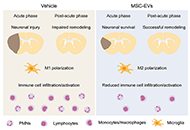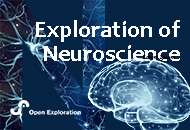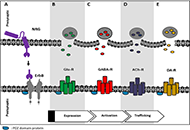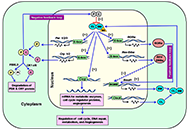Neuregulins: subcellular localization, signaling pathways and their relationship with neuroplasticity and neurological diseases
Neuregulins (NRGs) and their cognate ErbB receptors (ErbB2–ErbB4) constitute a vast group of proteins encoded by six different genes (
NRG1–
6) and many isoforms with critical
[...] Read more.
Neuregulins (NRGs) and their cognate ErbB receptors (ErbB2–ErbB4) constitute a vast group of proteins encoded by six different genes (NRG1–6) and many isoforms with critical roles in the development and functioning of the nervous system. NRGs are known to regulate important processes in the nervous system like neural development, neuronal differentiation, neurite outgrowth, and specification. These factors are involved in the regulation of neurotransmission pathways and the modulation of several forms of synaptic plasticity. Due to NRGs’ role in synaptic plasticity, defects in their normal functioning are translated into altered signaling networks, which have been linked to susceptibility to developing psychiatric disorders like schizophrenia (SZ), autism, depression, and bipolar disorders. Additionally, deviation of the NRG normal functioning is involved in neurological diseases like Alzheimer’s and Parkinson’s disease. Contrastingly, NRG/ErbB signaling is also involved in the recovery after traumatic brain injuries (e.g., ischemic stroke). The NRG/ErbB signaling complex is highly unusual because the ligands (mainly NRG1–NRG3, with their multiple isoforms) and receptors (ErbB2–ErbB4) can orchestrate vast signaling complexes, with a wide reach within the processes that govern the development and appropriate function of the nervous system. This may explain why NRGs and ErbB receptor genes have been linked to complex brain disorders, like SZ. This review, are discussed important aspects of NRG and their relevance for nervous system functioning, including 1) subcellular localization, 2) signaling pathways involved in neuronal functions, 3) effect on neurite development and synapse formation, 4) modulation of some mechanisms of synaptic plasticity [long-term potentiation (LTP), depotentiation, long-term depression (LTD)] and 5) roles of NRGs in some neurological diseases. This review intends to present a summary of the main findings about this family of proteins, which might position them as one of the master regulators of brain functioning.
Marines Longart ... Juan Carlos Martínez
Neuregulins (NRGs) and their cognate ErbB receptors (ErbB2–ErbB4) constitute a vast group of proteins encoded by six different genes (NRG1–6) and many isoforms with critical roles in the development and functioning of the nervous system. NRGs are known to regulate important processes in the nervous system like neural development, neuronal differentiation, neurite outgrowth, and specification. These factors are involved in the regulation of neurotransmission pathways and the modulation of several forms of synaptic plasticity. Due to NRGs’ role in synaptic plasticity, defects in their normal functioning are translated into altered signaling networks, which have been linked to susceptibility to developing psychiatric disorders like schizophrenia (SZ), autism, depression, and bipolar disorders. Additionally, deviation of the NRG normal functioning is involved in neurological diseases like Alzheimer’s and Parkinson’s disease. Contrastingly, NRG/ErbB signaling is also involved in the recovery after traumatic brain injuries (e.g., ischemic stroke). The NRG/ErbB signaling complex is highly unusual because the ligands (mainly NRG1–NRG3, with their multiple isoforms) and receptors (ErbB2–ErbB4) can orchestrate vast signaling complexes, with a wide reach within the processes that govern the development and appropriate function of the nervous system. This may explain why NRGs and ErbB receptor genes have been linked to complex brain disorders, like SZ. This review, are discussed important aspects of NRG and their relevance for nervous system functioning, including 1) subcellular localization, 2) signaling pathways involved in neuronal functions, 3) effect on neurite development and synapse formation, 4) modulation of some mechanisms of synaptic plasticity [long-term potentiation (LTP), depotentiation, long-term depression (LTD)] and 5) roles of NRGs in some neurological diseases. This review intends to present a summary of the main findings about this family of proteins, which might position them as one of the master regulators of brain functioning.
 Neuroprotective and neurorestorative actions of mesenchymal stromal cell-derived small extracellular vesicles in the ischemic brainOpen AccessReviewIschemic stroke is a highly prevalent condition that frequently results in life-long disability and death. Considerable efforts have been made to establish treatments that prevent secondary ischemic [...] Read more.Chen Wang ... Dirk M. HermannPublished: October 09, 2022 Explor Neurosci. 2022;1:61–74
Neuroprotective and neurorestorative actions of mesenchymal stromal cell-derived small extracellular vesicles in the ischemic brainOpen AccessReviewIschemic stroke is a highly prevalent condition that frequently results in life-long disability and death. Considerable efforts have been made to establish treatments that prevent secondary ischemic [...] Read more.Chen Wang ... Dirk M. HermannPublished: October 09, 2022 Explor Neurosci. 2022;1:61–74 Recent developments and future perspectives of neuropathologyOpen AccessPerspectiveThis brief statement describes some recent achievements of neuropathological research, with the focus on Alzheimer’s and other age-related diseases, neurodegenerative disorders (tauopathies, synucleinopathies), multimorbidity of [...] Read more.Kurt A. JellingerPublished: September 30, 2022 Explor Neurosci. 2022;1:54–60
Recent developments and future perspectives of neuropathologyOpen AccessPerspectiveThis brief statement describes some recent achievements of neuropathological research, with the focus on Alzheimer’s and other age-related diseases, neurodegenerative disorders (tauopathies, synucleinopathies), multimorbidity of [...] Read more.Kurt A. JellingerPublished: September 30, 2022 Explor Neurosci. 2022;1:54–60 Neuregulins: subcellular localization, signaling pathways and their relationship with neuroplasticity and neurological diseasesOpen AccessReviewNeuregulins (NRGs) and their cognate ErbB receptors (ErbB2–ErbB4) constitute a vast group of proteins encoded by six different genes (NRG1–6) and many isoforms with critical [...] Read more.Marines Longart ... Juan Carlos MartínezPublished: September 29, 2022 Explor Neurosci. 2022;1:31–53
Neuregulins: subcellular localization, signaling pathways and their relationship with neuroplasticity and neurological diseasesOpen AccessReviewNeuregulins (NRGs) and their cognate ErbB receptors (ErbB2–ErbB4) constitute a vast group of proteins encoded by six different genes (NRG1–6) and many isoforms with critical [...] Read more.Marines Longart ... Juan Carlos MartínezPublished: September 29, 2022 Explor Neurosci. 2022;1:31–53 Impact of circadian clock dysfunction on human healthOpen AccessReviewAll living organisms exhibit circadian rhythms. Humans show circadian rhythm of the different physiological functions such as sleep-wake cycle, core body temperature, feeding behavior, metabolic act [...] Read more.Saptadip Samanta, Sk Asif AliPublished: September 29, 2022 Explor Neurosci. 2022;1:4–30
Impact of circadian clock dysfunction on human healthOpen AccessReviewAll living organisms exhibit circadian rhythms. Humans show circadian rhythm of the different physiological functions such as sleep-wake cycle, core body temperature, feeding behavior, metabolic act [...] Read more.Saptadip Samanta, Sk Asif AliPublished: September 29, 2022 Explor Neurosci. 2022;1:4–30 Cutting edges in neuroscience to exceed bordersOpen AccessEditorialDirk M. HermannPublished: September 01, 2022 Explor Neurosci. 2022;1:1–3
Cutting edges in neuroscience to exceed bordersOpen AccessEditorialDirk M. HermannPublished: September 01, 2022 Explor Neurosci. 2022;1:1–3